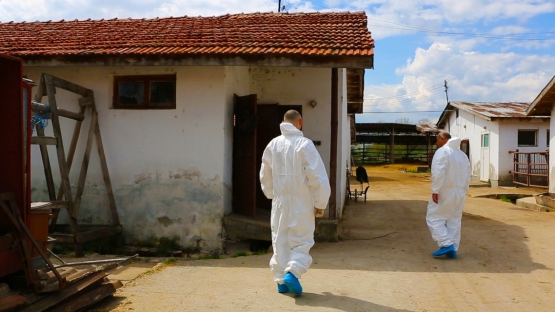Bulgaria has halted the spread of the Peste des Petits Ruminants (PPR) — a virus disease that can devastate livestock — thanks, in part, to the support of the IAEA and the Food and Agriculture Organization of the United Nations (FAO). This was the first time PPR was recorded in the European Union, so halting its spread early is of regional importance.
Outbreak in the summer
Last summer in the farms of Voden, southeastern Bulgaria, cattle breeders noticed that their animals were suffering from disease. Soon after, authorities reported that the country was facing an outbreak of PPR. Within days, two Bulgarian scientists came to the IAEA to receive training and materials to rapidly detect and characterize the PPR virus using nuclear-derived techniques (see The Science). Today, the area is under active surveillance, and no more cases have been reported since July 2018.
PPR, although not transmitted to humans, can have a severe impact on livestock, killing between 50 to 80 % of infected animals, mostly sheep and goat. Its high economic impact makes PPR one of the major livestock diseases. Also known as ovine rinderpest or sheep and goat plague, PPR is originally from Africa but has been reported in Asia and the Middle East, too.
“Most of the European laboratories are generally neither familiar nor prepared to deal with this disease,” said Giovanni Cattoli, Head of the Animal Production and Health Laboratory at the Joint FAO/IAEA Division of Nuclear Techniques for Food and Agriculture. “It is exotic; off their radar. But, luckily, Bulgaria reacted quickly and we stepped up to support them.”
The EU’s Reference Laboratory for PPR, based in Montpellier, France, later confirmed their findings.
Immediately after the outbreak was confirmed, authorities imposed a quarantine zone around the village of Voden to contain the disease, ordered blood tests on small livestock and banned trade and transport of all livestock in the regions bordering Turkey, where the disease is present.
As a consequence of the emergence of the disease, animal movement restrictions and trade barriers were put in place to limit the spread of the infection and facilitate its eradication. This is standard procedure in the European Union. Six months after the last case occurred, the active surveillance implemented by the Bulgarian veterinary services indicates that the virus is no longer circulating in the country — a pre-requisite to lift the ban.
Today, Bulgarian authorities are implementing active surveillance in the area to remove any possibly infected animals from herds. “We have a lot of confidence in Bulgaria’s capacity to control the disease, but work should continue,” Cattoli said. “The same way it reached Bulgaria, it could reach other European countries.”
Eradication?
After the world declared in 2011 the eradication of rinderpest, PPR’s ‘older sister’ disease that affects bigger livestock such as cows, the FAO and the World Organisation for Animal Health (OIE) set a goal for the global eradication of PPR by 2030. Achieving this could have a major positive impact on affected economies. Freeing Africa alone of rinderpest in 2011, for example, led to an annual estimated economic benefit to the region of US$ 920 million, according to FAO estimates.
“If you look at the virus and the epidemiology of the disease, technically this is achievable,” Cattoli said, referring to the eradication of PPR. “The difference is that there are far more goats and sheep whose location and movements are sometimes difficult to trace, so having exact figures and calculating the right doses for a vaccine programme can be a challenge.”
In partnership with the FAO, the IAEA assists national experts in developing and adopting nuclear-based technologies to optimize animal health management practices. These techniques, such as ELISA and PCR, are extremely sensitive and precise (see The Science).








